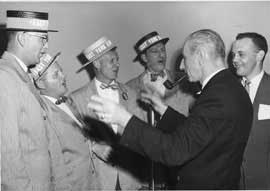Kin History

On Feb. 20, 1920, Hal Rogers and 11 men gathered for a meeting at the Namking Cafe in Hamilton,ON. This group formed the first club in our organization – the Kinsmen Club of Hamilton (ON).
These men found that budding relationships alone were not sufficient enough to sustain a continued interest and decided to perpetuate the ideal of service in peace time as they had done in the war years; thus our organization became a service organization.
Soon, one of these enthusiastic members moved to Montreal and formed a second club; later a member moved to Winnipeg and formed a club there; then before long a member moved to Vancouver, and a fourth club was formed. Thus, in a short span of four years, Kinsmen clubs had a foothold from Montreal to the west coast.
At a national convention in Winnipeg in the summer of 1926, the course of Kinsmen became more clear. After a hotly debated session, it was decided Kinsmen would not become an international organization but a national service club; a new constitution and bylaws were presented and adopted, and a maximum age limit of 40 for active membership was set. An important factor in setting this age restriction was that it was part of the agreement that convinced the four Eclectic clubs of Saskatchewan to join our Association. A prominent member of the Eclectic Clubs was John Diefenbaker, who argued effectively for the age restriction.
During the Great Depression, the Association grew in numbers of members and clubs and began to become structurally organized with districts and a national executive. The outbreak of the Second World War saw Kinsmen serve their country on the battlefields and through supplying the British armies with the first mobile dental clinic, which was built and financed by Kinsmen.
The national project during the war years was to supply Britain’s children with milk, and to this end the Association shipped over 50 million quarts to Britain. This could be considered, to date, the single most effective national Kin project.
After the war, the Association continued to grow and adopted even more ambitious projects. In 1949, the Association set up a Cancer Scholarship Fund to help train doctors in treating the dreaded disease.
Assistance to flood and hurricane devastated areas of the country and beyond demonstrated the Kinsmen commitment. By being dedicated to fellowship and service, the Association grew to more than 300 clubs and 10,000 members by 1956.
The Association experienced continual growth and expansion up until late 1970. A project that gained Kinsmen great public profile during this era was the founding and construction of the Kinsmen National Institute on Mental Retardation in Toronto.
Kinsmen and Kinettes today support cystic fibrosis research and have promoted much publicity and fundraising to try to defeat this disease. Members have made a dramatic impact on life in Canada.